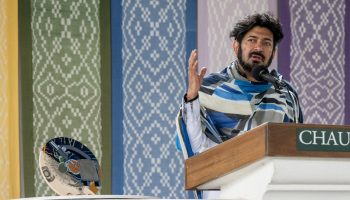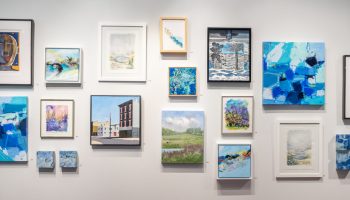When Abyssinian Baptist Church in Harlem was preparing to celebrate its bicentennial in 2008, it turned to Wynton Marsalis. The result was distinctly sacred.
Marsalis created The Abyssinian Mass — a large-scale, 19-movement work for a big band and a 70-piece gospel choir. In 2013, Marsalis and Jazz at Lincoln Center Orchestra were joined by conductor Damien Sneed and his choir, Chorale Le Chateau, for a 16-city tour.
During that tour, the mass was recorded and, on March 18, Marsalis’ first original recorded composition in six years was released as an album: The Abyssinian Mass.
At 8:15 p.m. tonight in the Amphitheater, all the players will be reunited, from Sneed and his Chorale to Marsalis and JLCO — and Abyssinian’s pastor, the Rev. Calvin O. Butts, III, will narrate the mass.
“[The mass] answers this question of searching for meaning in music and trying to reframe the dialogue around arts in America today,” said Seton Hawkins, manager of education resources as Jazz at Lincoln Center. “The Abyssinian Mass is something of a showcase of that. … It’s a really, really extraordinary piece.”
Beyond extraordinary: Chicago Tribune’s Howard Reich described The Abyssinian Mass as a “monumental opus” from Marsalis.
In a video posted to YouTube in November 2014, conductor Sneed discussed the musical and lyrical elements of the large-scale work, which “deal[s] with the religious aspects of the jazz music.”
“Other great composers have added to the musical thread of religious works,” Sneed said, mentioning Duke Ellington and jazz pianist Mary Lou Williams, who wrote a Lenten mass. “When you think about the mass, you think about the Catholic Church, the universal church. Generally, the mass was performed in Latin.”
But now, Sneed said, people have begun to create a mass that is not separated into the ecclesia and the laity.
“Now the masses have been written in a language everyone can understand,” he said.
In his review of The Abyssinian Mass for The Wall Street Journal, Will Friedwald called Marsalis’ composition “the closest that anyone has come to attaining that rarefied level of spirituality and swing.”
“Abyssinian Mass sustains its length not only by keeping everything melodically interesting, but through consistently original ideas about how to deploy the twin resources of jazz orchestra and gospel choir,” Friedwald wrote, noting the use of one of Marsalis’ “signature device[s]”: “[O]n closer listen, it becomes clear that the ‘voices’ … are a choir of vocalized moaning trombones, and the beat is supplied by handclaps … He has turned instruments into humans and vice-versa.”
In creating The Abyssinian Mass, Hawkins said, Marsalis took forms of traditional classical mass, with influences of Bach, Mozart or Brahms, and fused them with jazz.
“It represents a really remarkable composition of Wynton’s and a really, really amazing fusion of musical worlds,” Hawkins said.
Throughout the years, The Abyssinian Mass has grown, from the original 19 movements to 23. Over those movements, wrote Chicago Tribune’s Reich, the work “thunders and sighs, its massively scored passages yielding to plaintive vocal solos, its full-throated choral sections giving way to introspective instrumental cadenzas.”
In his YouTube video, Sneed encouraged listeners to pick up on musical themes throughout the mass, including the element of a train, particularly in “Recessional: ‘The Glory Train.’ ” Listeners will also find universal themes expressed lyrically, he said.
“One of these themes is that everyone has a place in the house of God,” Sneed said. “[The mass] is literally an expose on the culture of the church experience of the African-American diaspora.”
Staff writer Samantha Ickes contributed to this report.






